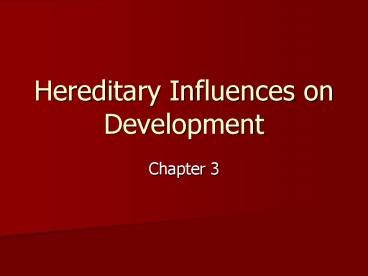Hereditary Influences on Development - PowerPoint PPT Presentation
1 / 31
Title:
Hereditary Influences on Development
Description:
'Regular' body cells mitosis. Sex cells meiosis. Crossing over ... Hair dark hair blonde, light, red hair. non-red hair red hair. curly hair straight hair ... – PowerPoint PPT presentation
Number of Views:132
Avg rating:3.0/5.0
Title: Hereditary Influences on Development
1
Hereditary Influences on Development
- Chapter 3
2
(No Transcript)
3
The Genetic Code
- Chromosomes
- Rodlike
- Store and transmit genetic information
- Matching pairs
- 46 chromosomes, 23 pairs
- Comprised of deoxyribonucleic acid, DNA
4
(No Transcript)
5
(No Transcript)
6
Gametes/Sex Cells
- Sperm, ovum
- Contain only 23 chromosomes
- Formed through meiosis
- Regular body cells ? mitosis
- Sex cells ? meiosis
- Crossing over
7
(No Transcript)
8
Multiple Offspring
- Identical/monozygotic twins
- Fraternal/dizygotic twins
9
(No Transcript)
10
Patterns of Genetic Influence
- Phenotype
- Genotype
- Can have same phenotype but different
genotypeswhy?
11
How Are Genes Expressed?
- Simple dominant-recessive inheritance
- Each different form of a gene is called an allele
- Alleles alike homozygousAlleles different
heterozygous
12
How Are Genes Expressed?
- Dominant-recessive
13
(No Transcript)
14
Examples of Dominant-Recessive Genes Dominant
Traits Recessive Traits
- Eye color brown eyes grey, green, hazel, blue
- Vision farsightedness normal vision
- normal vision nearsightedness
- normal vision night blindness
- normal vision color blindness
- Hair dark hair blonde, light, red hair
- non-red hair red hair
- curly hair straight hair
- full head of hair baldness
- widows peak normal hairline
- sex-linked characteristic
15
Examples of Dominant-Recessive Genes Dominant
Traits Recessive Traits
- Facial features dimples no dimples
- unattached earlobes attached earlobes
- freckles no freckles
- broad lips thin lips
- Appendages extra digits normal number
- fused digits normal digits
- short digits normal digits
- fingers lack 1 joint normal joints
- limb dwarfing normal proportion
- clubbed thumb normal thumb
- double-jointedness normal joints
16
Examples of Dominant-Recessive Genes Dominant
Traits Recessive Traits
- Other immunity to poison ivy
susceptibility to poison ivy - normal pigmented skin albinism
- normal blood clotting hemophilia
- normal hearing congenital deafness
- normal hearing and speaking deaf mutism
- normal no PKU phenylketonuria (PKU)
- sex-linked characteristic
17
How Are Genes Expressed?
- If heterozygous, can pass on a recessive allele
to children - Carriers
- Phenylketonuria (PKU)
18
How Are Genes Expressed?
- Sex-linked inheritance
- Codominance
- Polygenic inheritance
19
Hereditary Disorders
- Chromosomal abnormalities
20
(No Transcript)
21
Hereditary Disorders
- Autosomal abnormalities
- Most frequent is Down syndrome (trisomy 21)
- Mental retardation
- Distinctive physical features
- Mutations
22
Detecting Hereditary Disorders
- Amniocentesis
- Chorionic villus sampling
- Ultrasound
- Know the procedures, advantages, and
disadvantages of each
23
Genetic-Environmental Interactions
- Reaction range
24
Range of Reaction
25
Canalization
- Heredity restricts development of some
characteristics - Examples babbling, motor development
26
Behavioral Genetics
- The scientific study of how genotype interacts
with the environment to determine behavioral
attributes such as intelligence, personality, and
mental health - Methods of studying hereditary influences
- Selective breeding
- Family studies
- Twin studies
- Adoption studies
27
Behavioral Genetics
- Twin studies
- Identical/fraternal reared together
- Adoption studies
- Identical twins reared apart
- Calculate concordance rates
- Heritability coefficient
28
Behavioral Genetics
- Heritability coefficient (H) (r identical r
fraternal) X 2 - Environmental influences
- Nonshared environmental influences (NSE)
- 1 r identical twins reared together
- Shared environment influences
- 1 - (H NSE)
29
Behavioral Genetics
- Anxiety scale score
- Monozygotic twins r .78
- Dizygotic twins r .51
- Heritability
- 2(.78-.51)
- 2(.27)
- .54
- Nonshared
- 1 - .78 .22
- Shared
- 1 (.54 .22)
- 1 - .76 .24
30
Behavioral Genetics
- Favorite color
- Monozygotic twins r .26
- Dizygotic twins r .23
- Heritability
- 2(.26-.23)
- 2(.03)
- .06
- Nonshared
- 1 - .26 .74
- Shared
- 1 (.06 .74)
- 1 - .80 .20
31
Molecular Genetics
- To discover the precise locations of genes that
determine an individuals susceptibility to
various diseases and other aspects of health and
well-being - Genome complete set of instructions for making
an organism - Human Genome Project































